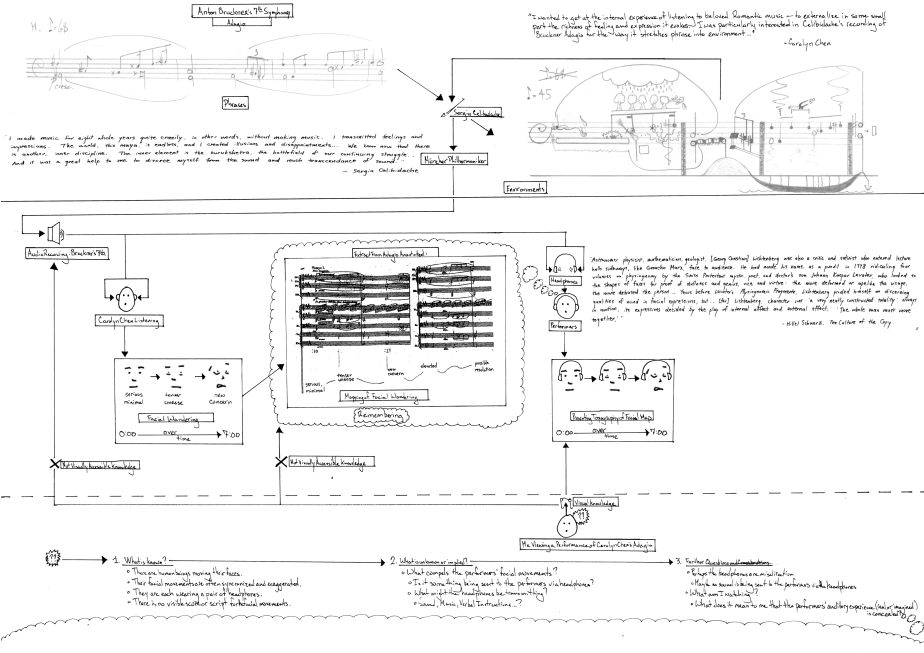“This first thing that we do when we come out of [the] womb is we take a breath. And the last thing that we do when we die is the breath runs out of our body.
“And then there’s this gap. There’s this kind of fascinating pause that comes at the end of an inhale, and it’s this space where everything drops away. When you’re giving it attention it’s very subtle, but it’s a moment of actual liberation. It’s not when you are gripped in the inhale at the end of it, but it’s more that gap that opens up just before the breath that is given.”
– Joan Halifax
Life—that space between the inhalation of birth and exhalation of death—is such a gap, an expanded gap filled with many such infinitesimally shorter gaps, what Evan Thompson describes as “hinge[s] … where the mind and body swing back and forth.”
* * *
Composer Antonia Barnett-McIntosh and flautist Ilze Ikse have come together to form life out of breath in the collaboratively developed piece Breath for alto flute. Breath was commissioned by Hubbub, inaugural residents of The Hub at Wellcome Collection, an interdisciplinary research project aimed at transforming how we as humans understand rest. In a musical context, a breath can be understood as musical rest, a moment of repose. Inversely, breathlessness can both take form from and as exhaustion. Breath is (nearly) all breath; Ilze is required to, as Antonia states, “utilise each in- and out-breath in the creation of sound,” thereby rendering her and her performance breathless, without musical rest, always intensely alive.
* * *
It starts with a breath in.
Ilze breathes in.
I breathe in.
When I listen to Breath I breathe. I breathe with Ilze, not simply alongside, but at the same time, for the same duration, and in the same direction. I switch between breathing through my nose here, my mouth there, exploring what it means to remain relaxed, sometimes switching between different ventilation circuitry responsible for the circulation of shared air, sometimes, somewhere, unsure whether or not I am breathing through mouth or nose. The physicality of both bodies becomes emphatically sonified; I merge into the form of Breath, which is essentially a life form, a living form: Ilze’s breath and body. I am stretched; breaths in Breath are not natural, they are extended and exhausting, sometimes uneven and strained. Other times, unrestrained, they swell, they compel and propel me forward, excite my spectral inhales and exhales. Nevertheless, breathing abides by a rhythmic logic, in is followed by out is followed by in is followed by out, and so forth; breaths reassuringly comfort even while their limits are pushed. They are a guide through, and glue to, the extraordinarily diverse range of sounds coaxed out of the instrumental prosthesis, an instrumentalised lung. Sounds that modulate and colour my sensation of breathing, an upper harmonic that gently brushes up against a slight whistle passing through my nasal cavity, a deeply hollowed breeze that tugs my lips an inch wider ajar. Sounds that flicker on the threshold of stability, that imbue my voice with a silent, resonating Barthian ‘grain’ — “tas sadalās, krakšķ, glāsta, skrāpē, griež: tā ir ekstāze.”
My mouth and nose become breathing ears. They act as hinges where mind and body swing back and forth. They turn listening into mutually exhaustive rest. They feel and hear carnal being as musical being.
This is how I listen to Breath.
* * *
Film of Ilze Ikse performing Breath
* * *
Come listen to Ilze Ikse perform Breath live on the 23rd of July at the Hundred Years Gallery, 8pm, as part of the 8th volume of WEISSLICH.
–Michael Baldwin

